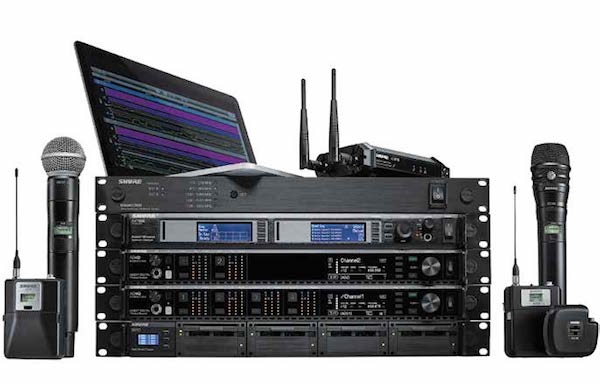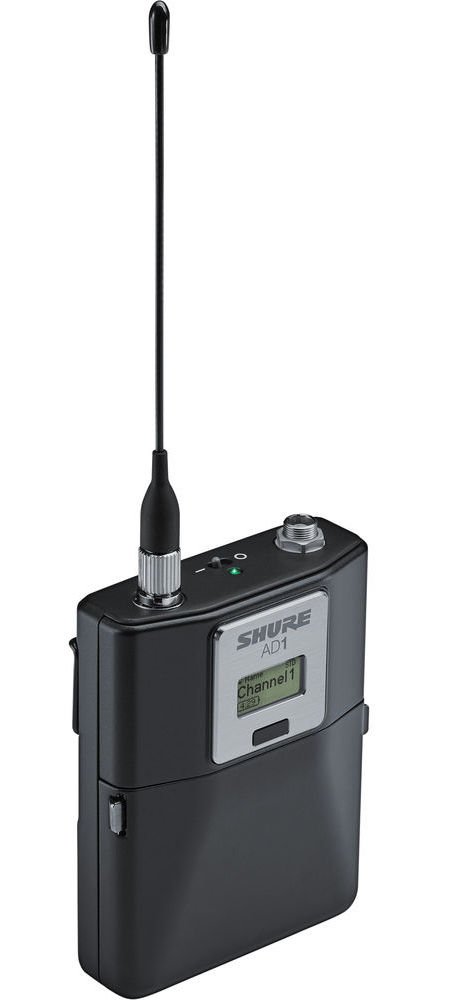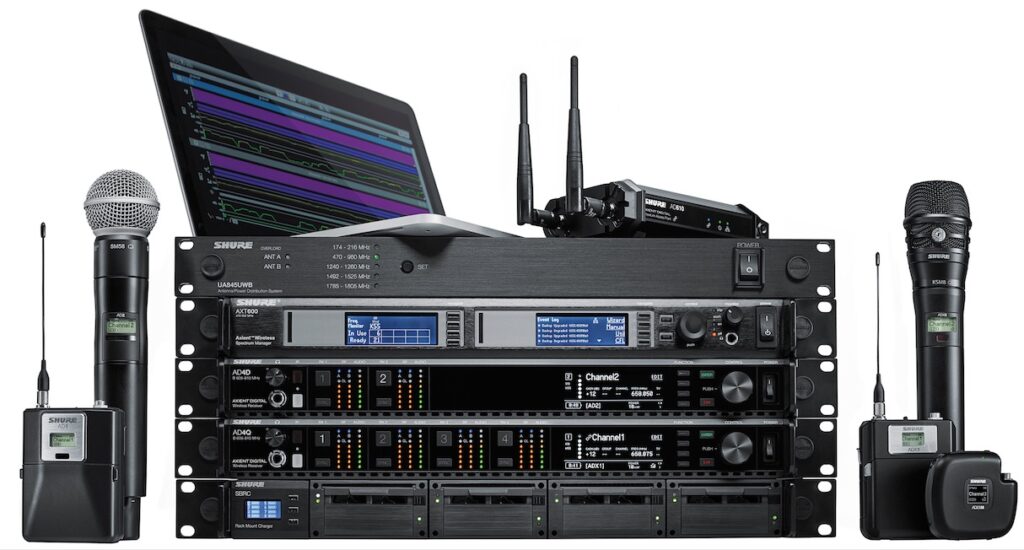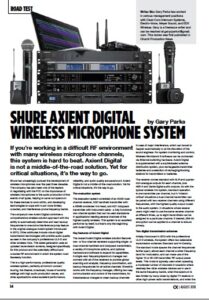Subscribe to CX E-News
Road Test
Shure Axient Digital Wireless Microphone System
By Gary Parks.
If you’re working in a difficult RF environment with many wireless microphone channels, this system is hard to beat. Axient Digital is not a middle-of-the-road solution. Yet for critical situations, it’s the way to go.
Gary Parks has worked in various management positions with Clear-Com Intercom Systems, Electro-Voice, Meyer Sound, and EDX Wireless. Gary is a freelance writer and can be reached at garycparks1@gmail.com
This review was first published in Church Production News.
Shure has unceasingly pursued the development of wireless microphones over the past three decades. The company has also been one of the leaders in negotiating with the FCC on the importance of wireless microphones to the audio production of live events of all types, helping to carve out spectrum for these devices to work within, and developing technologies to cope with much more limited, crowded, and interference-prone frequency bands.
The company’s new Axient Digital combines a comprehensive wireless solution approach with the ability to automatically determine and load backup frequencies to overcome interference (a key feature in the original analogue Axient system introduced in 2011).
Other attributes include robust digital transmission technologies with pristine audio quality as seen in the company’s professional ULX-D and other wireless mics. This latest generation uses an updated transmission scheme, designed specifically for this product and the potentially difficult and crowded RF environment in which the system must flawlessly function.
This is a high-performance, professional quality wireless system, perfectly at home in concert touring, live theatre, broadcast, house of worship settings with high audio production values, and other applications where excellent performance, reliability, and audio quality are paramount.
Axient Digital is not a middle-of-the-road solution. Yet for critical situations, it’s the way to go.
The evaluation system
The evaluation system consisted of an AD4D dual-channel receiver, AD2 handheld transmitter with a KSM9 condenser mic head, and AD1 bodypack transmitter with instrument cable – a fully functional two-channel system that can be used standalone in applications needing several channels of the highest quality wireless.
This system is an excellent performer by itself, but that’s only the beginning with Axient Digital.
Key features of Axient Digital
The overall Axient Digital wireless solution features two- or four-channel receivers supporting single- or dual-channel handheld and bodypack transmitters, a variety of microphone options, and optional hardware and software to expand its capabilities.
A single-rack frequency/spectrum manager can connect with all of the receivers to provide global scanning and analysis, frequency coordination, and backup frequencies for all active channels. Showlink works with the frequency manager, offering two-way communication and control of the transmitters, for instantaneous changes to clean backup channels in case of major interference, which can be set to happen automatically or at the discretion of the sound engineer.
For system monitoring and control, Wireless Workbench 6 software can be connected via Ethernet switching hardware. Axient Digital is supplemented with a sophisticated antenna distribution system, plus rechargeable transmitter batteries and a selection of recharging/docking stations for transmitters or batteries.
The receiver comes standard with XLR and quarter-inch analogue outputs for each channel, plus AES-3 and Dante digital audio outputs. As with the typical wireless mic system, standard operation is one transmitter per channel, but in ‘mission critical’ situations a dual-channel transmitter can be paired with two receiver channels using different frequencies, with the highest quality output routed to the audio system.
In situations where several users might need to use the same receiver channel at different times, up to eight transmitters can be assigned to a particular channel. If desired, 256-bit encryption can be applied to a channel to ensure privacy.
Two digital transmission schemes
Initially introduced in 2012 with the professional ULX-D wireless, the system offers two selectable transmission schemes: Standard and Hi-Density. The standard mode spaces the channel frequencies farther apart, allows each channel a wider frequency band for modulation, and can make use of the higher 10 or 35 mW transmitter RF output power levels.
This mode is typically used when operating a moderate number of channels in locations where relatively few other wireless devices are in use in the same frequency bands, when the spectrum is less limited by many close-by digital TV stations or other high-power radio transmissions, and when the transmitters are being used at a significant distance from the receiver antennas, and maximum range is paramount.
Up to eight transmitters can be assigned to a particular channel; useful for multiple presenters or musical instrument changes. Hi-Density mode allows many channels to operate cleanly within a limited block of spectrum (for example, when only one 6 MHz open television channel is available, up to 47 active transmitters can be used), with much closer spacing of the frequencies.
One aspect of this mode utilizes the lowest 2mW transmitter output setting option so that the low transmission output of a particular transmitter is less likely to mix with that of other transmitters, creating lower intermodulation interference and effectively yielding a “cleaner” RF environment for the system to operate in.
Clear frequencies for each channel can be selected by using the receiver to scan the current RF environment, after which it suggests particular pre-coordinated groups of frequencies for each of the transmitter/receiver pairs within the system. The system also allows the selection of specific frequencies, which can then be stored in ‘custom’ groups in situations where a frequency coordinator assigns them.
New digital modulation scheme
For Axient Digital, the digital transmission technology was rethought, based on Shure’s deep history with both analogue and digital wireless. With an analogue wireless signal, as the user approaches the range limit of the transmitter or is in a location where its RF signal is blocked by some object, the quality of the audio noticeably degrades as the signal strength at the receiver becomes too low, providing a warning that a dropout is impending.
Digital wireless receivers can operate effectively at lower signal levels, and the audio typically remains clean until all of a sudden it’s silent; a relatively rare occurrence in normal situations, but disconcerting.
According to Shure, the newly developed RF modulation scheme used with Axient Digital helps eliminate the already relatively low probability of signal dropouts in difficult environments, resulting in increased range and reliability without a degradation in audio quality.
The AD4D receiver
At a glance, there’s no mistaking that this receiver is structurally and functionally a highly professional piece of equipment – with clean lines and impeccable fit and finish on both the front and rear panels. It is designed and manufactured to withstand the rigours of touring.
Front-panel controls are solid and firm, and rear-panel inputs and outputs are high-quality and well anchored to the chassis. Each channel has an XLR and quarter-inch analogue output, including mic/line and ground-lift toggle switches. In addition, digital audio outputs are provided, with both an AES3 connector and Dante ports.
Accommodating large systems where an external word clock is used to coordinate all of the digital equipment, in and through ports are in place. Ethernet ports support networking and control systems, such as Wireless Workbench 6. A locking AC power connector is paired with a power cascade port for additional receivers.
The front panel is well laid out, with headphone connector and volume knob on the left, channel controls and indicators plus the backlit display in the centre, and menu and navigation controls on the right.
An infrared window communicates with its mate on the transmitter for pairing, and there is even an ambient light sensor to detect and accommodate display lighting based on the lighting in the room.
Pushbuttons for channels one and two provide a shortcut for viewing and editing channel parameters, and the three LED ladders clearly indicate RF signal strength, interference, and audio level. Menu enter and exit buttons and a rotary controller navigate the many editable parameters, and four programmable function buttons give immediate access to specific configuration options. Menu options are plentiful.
AD1 Bodypack and AD2 Handheld Transmitters
The transmitters continue the professional look and feel of the system. The black matte-finished metal cases fit together precisely, and are solid in the hand. Both feature a small LCD display screen, an infrared sensor, exposed charging connector for recharging batteries in a docking station, and an accessible yet recessed on/off switch.
Transmitters will run for eight hours with a pair of AA alkaline batteries, or over 11 hours using the proprietary rechargeable unit (at the 10 mW output level).
The transmitter parameters menu controls are within the battery compartment, so changes can be made there, or via the receiver and IR link or networked with Wireless Workbench software and Showlink. Those parameters allow the controls to be locked, frequencies and channels to be set, selection of RF output level, mic level, a 400 Hz or 1kHz test tone generator (for audio system setup or troubleshooting), transmitter naming, and more.
To achieve the most accurate reading of remaining battery life, settings are available for alkaline, lithium, and NiMH types; when using the Shure battery pack the display is automatically accurate.
The handheld transmitter is very quiet in terms of handling noise, due to its dense construction, and is comfortable and balanced in the hand. Rubbing a finger or thumb over the power switch doesn’t accidentally move it, but it is easily activated with a fingernail; a very good design and placement.
A variety of microphone heads may be threaded onto the handle/electronics, such as the SM58, Beta 58, Beta 87, KSM8, and KSM9. The bodypack transmitter is slim and compact, with a fairly well recessed on/off toggle switch on the top–located between the threaded whip antenna and the mic input connector (a TA4 mini-XLR type). The switch is the only external control, and locking it to prevent accidental turnoff might be a good practice in critical applications.
The battery compartment is a fine compromise between easy one-handed accessibility and security from opening during use.
System performance
The system sounds transparent and virtually noiseless, with a flat frequency response across the 20 Hz to 20kHz audio spectrum. The qualities and response characteristics of the particular microphones, voices, and instruments come through clearly. For example, the handheld transmitter sounded just like a wired KSM9 microphone and the response of an excellent acoustic guitar through the bodypack transmitter matched the wired sound.
The final word
Axient Digital is one of the best, most advanced, and most comprehensive wireless microphone solutions available, building a host of practical professional options onto a clean, reliable, great sounding audio signal.
It’s not an investment for everyone, and Shure offers many excellent wireless systems at a variety of price points. However, if you’re working in a difficult RF environment with many wireless channels, demanding the best results, this system is hard to beat.
Brand: Shure
Model: Axient Digital
Pricing: (RRPs inc GST) Dual Receiver $6,245, Quad Receiver $12,445, Handheld Transmitter $3,145, Bodypack Transmitter $1,595, Jack to TA4F Instrument Cable $87.99
Product Info: www.shure.com
Distributor: www.jands.com.au
This article first appeared in the print edition of CX Magazine August 2018 pp.54-56. CX Magazine is Australia and New Zealand’s only publication dedicated to entertainment technology news and issues. Read all editions for free or search our archive www.cxnetwork.com.au
© CX Media
Subscribe
Published monthly since 1991, our famous AV industry magazine is free for download or pay for print. Subscribers also receive CX News, our free weekly email with the latest industry news and jobs.




















